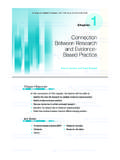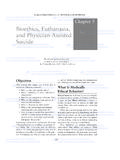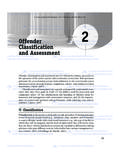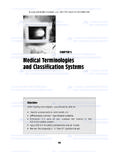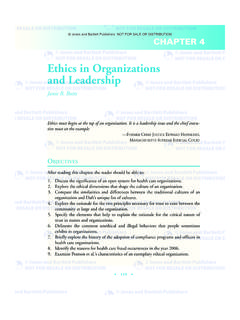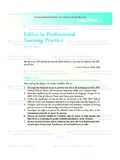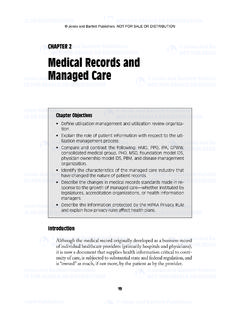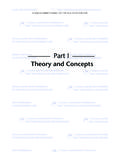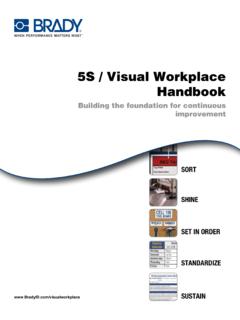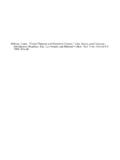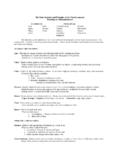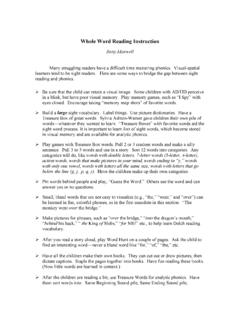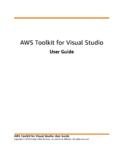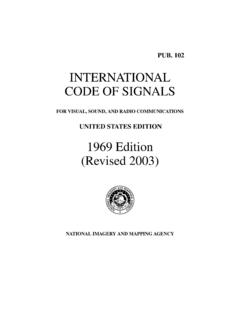Transcription of Introduction to Visual Basic
1 Elements of a Visual Basic Getting Started in Visual Adding an Event Adding Adding Additional Event Focus on Program Design and Implementation:Creating a Main Knowing About: The Help Common Programming Errors and Chapter ReviewIntroduction to VisualBasic . 11/10/04 12:44 PM Page 4546|Chapter 2: Introduction to Visual Basic .NETIn this chapter we begin learning about the fundamentals of programming and VisualBasic .NET. First we examine the two elements that are required by every practicalVisual Basic program: the screens and instructions seen by the user, and the behind thescenes processing that is done by the program.
2 We then present the Basic design win-dows that you must be familiar with to produce such programs. Finally, we show youhow to use these design windows to create the Visual user interface, or GUI, and thenadd processing of a Visual Basic ApplicationVisual Basic was initially introduced in 1991 as the first programming language thatdirectly supported programmable graphical user interfaces using language-suppliedobjects. From that time until 2002, there were five other versions released, each versionhaving features that increased the power of the language. In 2001, Microsoft releasedthe.
3 NET (pronounced dot net ) platform. Visual Basic .NET, or , is an upgradeto the last version of VB (version ) that conforms to the .NET platform. As you willsee in subsequent chapters, the changes in allow programmers to write Web ordesk-top applications within the same language. In addition, is fully object-ori-ented as opposed to prior versions that had many, but not all, of the elements of anobject-oriented language. This book is based on In the balance of the book wewill sometimes refer to Visual Basic as VB, omitting . a programming viewpoint, Visual Basic is an object-oriented language that con-sists of two fundamental parts: a Visual part and a language part.
4 The Visual part of thelanguage consists of a set of objects, while the language part consists of a high-level pro-cedural programming language. These two elements of the language are used together tocreate applications. Anapplicationis simply a Visual Basic program that can be run underthe Windows operating system. The termapplicationis preferred to the termprogramfortwo reasons: one, it is the term selected by Microsoft to designate any program that can berun under its Windows Operating System (all versions) and two, it is used to avoid confu-sion with older procedural programs that consisted entirely of only a language , for our purposes we can express the elements of a Visual Basic application as.
5 Visual Basic Application = Object-Based Visual Part + Procedural-Based Language PartThus, learning to create Visual Basic applications requires being very familiar withboth elements, Visual and Visual ElementFrom a user s standpoint, the Visual part of an application is provided within a is the graphical interface that allows the user to see the input and output 11/10/04 12:44 PM Page Elements of a Visual Basic Application|47 Figure 2 1A User s View of an ApplicationFigure 2 2 The Design Form on which Figure 2 1 is Basedby the application. This user interface is referred to as the graphical user interface(GUI).
6 From a programmer s perspective the GUI is constructed by placing a set of visualobjects on a blank window, or form, when the program is being developed. For exam-ple, consider Figure 2 1, which shows how a particular application would look to theuser. From a programmer s viewpoint, the application shown in Figure 2 1 is based onthe design form shown in Figure 2 2. The points displayed on the form are a design gridused to arrange objects on the form and are only displayed during design Form (Initial Form Window)Design 11/10/04 12:44 PM Page 4748|Chapter 2: Introduction to Visual Basic .
7 NETF igure 2 3 The Standard Visual Basic ToolboxThe programmer can place various objects on this form, which is itself a VisualBasic object. When an application is run, the form becomes a window that provides thebackground for the various objects placed on the form by the programmer. The objectson the window become the controls used to direct program events. Let s take a momentto look at the objects provided in the Visual Basic Toolbox. The standard object Tool-box, which is illustrated in Figure 2 3, contains the objects we will use in constructingeach graphical user 11/10/04 12:44 PM Page Elements of a Visual Basic Application| 49 Table 2-1 Fundamental Object Types and Their UsesObject TypeUseLabelCreate text that a user cannot directly or display an action, such as a display or one option from two mutually exclusive one option from a group of mutually exclusive a list of items from which one can be a list of items from which one can be selected, as well as permit users to type the value of the desired a timer to automatically initiate program text or NotesForms and ControlsWhen an application is being designed.
8 A formis a container upon which controls areplaced. When an application is executed, the form becomes either a window or a dialog can be of two types: SDI or MDI. The acronym SDI stands for Single Document Inter-face, which means that only one window at a time can be displayed by an application. SDIapplications can have multiple windows, but a user can only view one window at a acronym MDI refers to Multiple Document Interface, which means the application con-sists of a single parent or main window that can contain multiple child or internal win-dows. For example, the Notepad application supplied with the Windows operating system isan SDI application, while Excel and Access are both MDI control is an object that can be placed on a form, and has its own set of recognized prop-erties, methods, and events.
9 Controls are used to receive user input, display output, and trig-ger event majority of applications can be constructed using a minimal set of objects pro-vided by the standard object Toolbox. This minimal set consists of the Label, TextBox,and Button objects. The next set of objects that are more frequently found in applica-tions include the CheckBox, RadioButton, ListBox, and ComboBox. Finally, the Timerand PictureBox can be used for constructing interesting moving images across the win-dow. Table 2 1 lists these object types and describes what each object is used for. Theremaining sections of the text will describe the use of objects in the toolbox, with spe-cial emphasis on the four objects (Label, TextBox, Button, and ListBox) that you will usein almost every application that you addition to the Basic set of controls provided in VB, a great number of objects canbe purchased either for special purpose applications or to enhance standard 11/10/04 12:44 PM Page 4950|Chapter 2: Introduction to Visual Basic .
10 NETF igure 2 4An Event Triggers the Initiation of a ProcedureDon t be overwhelmed by all of the available controls. At a minimum, you willalways have the objects provided by the standard Toolbox available to you, and theseare the ones we will be working with. Once you learn how to place the Basic controlobjects on a form, you will also understand how to place the additional objects, becauseevery object used in a Visual Basic application, whether it is selected from a standard orpurchased control, is placed on a form in the same simple manner. Similarly, each andevery object contains two Basic characteristics: properties and object s propertiesdefine particular characteristics of the object.
